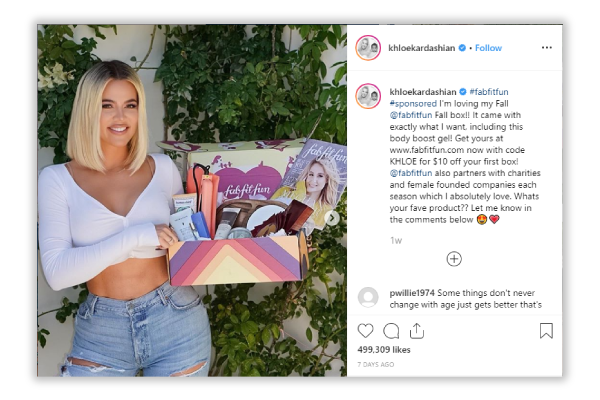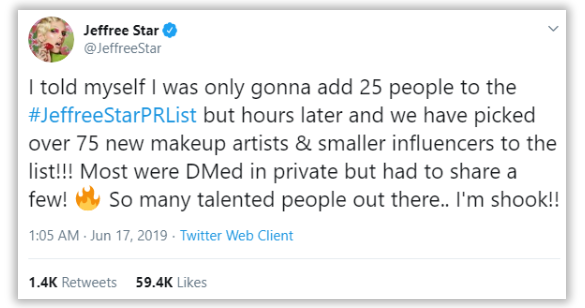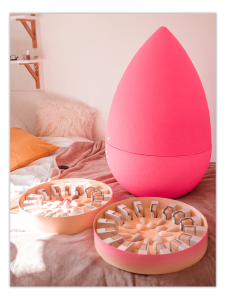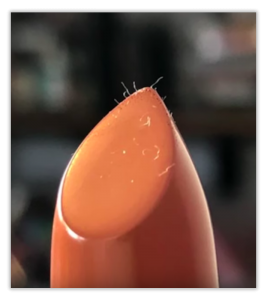

Influencer Marketing 101: Outreaching Your Products & Maximising Results
There’s no surprise when businesses say that influencer marketing is one of the fastest-growing marketing tactics. Its amazing growth is all down to the incredible value it offers brands and with the rise of digital influencers, there’s certainly no shortage of who to choose.
We’ve all seen those posts with the Kardashians subtly promoting products, and there’s no denying that though it’s an expensive initial layout, the Kardashian’s audience reaches millions of people with just a single post and has the ability to make a product sell out in seconds.
If you’re looking to spike sales traffic, perhaps influencer marketing could be for business. Here are our top tips on how you can outreach your products to maximise your results. (If you want to miss out on reading about the Kardashians, you can click here, and skip to our top tips!)
What is Influencer Marketing?

Influencer Marketing takes the idea of celebrity endorsement and modernises it by placing it within social media; making it much more accessible to a wider audience.
Unlike celebrities, influencers can be anybody with a big enough social presence and they tend to have a certain niche or industry that they specialise in. For instance, you could be an influencer for food, travel or even fashion – the possibilities are endless. As this form of marketing goes out to the influencer’s followers, you tend to find that it is extremely targeted and can lead to high engagement levels when done successfully.
How to Create a Successful Influencer Strategy
Just like all marketing campaigns, influencer marketing requires a lot of thought and a clear strategy on how you’re going to get the best return.
When creating your influencer marketing strategy, remember this rule of 3…
1. What is your objective?
Before doing anything, you need to identify your goals in order to create the perfect strategy that works for your business.
Each business' goals are different when it comes to influencer campaigns, but some common ones include:
Boost sales
Increase engagement
Drive your brand awareness
Target new audiences
2. Who do you want to target?
With such a wide variety of influencers out there, it can be difficult to know who will give you the best return and to be honest, you will never truly know until you try. However, you can narrow the search down by considering these factors:
Consider who your product’s target audience is –
If you’re looking to pay for your products to be promoted, you need to have a thorough understanding of who they’re targeted at while helping you choose what kind of influencer you need to be looking at.
How much budget do you have?
If you’re looking to hire the Kardashians with a small budget, you can think again. Though it’s reported that the products they endorse sell out ‘immediately’, you certainly pay for it. Just a single post from the Kardashians can cost between $598,000-$1.27 Million to reach their millions of followers.
Take a look at the influencer’s engagement rates and demographics –
If you are a company looking to target young women who like travelling, it may not be the best decision to partner with an influencer whose following and engagement is predominantly from older men. After all, size doesn’t always matter… but engagement does! The main ways to measure engagement success is by the number of likes, shares and comments. Other ways for you to measure the success would be to review other sponsored posts and see how many people used the promo codes/converted. Even though this would be for a different product, it can give you a good indication of performance.
3. How will you measure your success?
After promoting your product, you will need to evaluate the success of the campaign and whether it would be worth considering in the future. When outlining your influencer campaign strategy, you need to ensure that you know how you will be measuring it, and these should coincide with your business goals.
If the campaign is unsuccessful, you should look into why that may have been as there can be many factors that influence this, but you should ask yourself and the marketing team, ‘What could you have done differently?’
Perhaps it wasn’t the best season for your promotion, or maybe what you thought was your target audience turned out not to be a different one entirely.
Pros & Cons of Influencer Marketing
Like all things, influencer marketing can bring many benefits to your business as well as a few cons.
Pros:
Build trust and credibility with your audience –
By making your product seem endorsed by influencers, it can make your brand seem more desirable.
Increase your brand’s reach –
Depending on their popularity,
using influencers can help your business increase the number of people you reach.
Build a relevant audience –
As long as you target influencers who work within your industry and have a following of people who match your target audience, influencer marketing can be a great way to grow brand recognition with a greater audience.
Cons:
Can do more harm than good –
It can take a lot of time and effort to find the right influencers for your brand and products, and if done incorrectly, it can damage your brand’s reputation. Some common mistakes that influencers make which can damage your brand include:
Not disclose that the post is sponsored
Posting content that doesn’t resonate with the brand’s target audience
Creating posts that do not abide by your brand guidelines
It’s difficult to measure results –
Measuring the results from an influencer campaign can be difficult as you may not get an immediate payoff. It’s important to remember that growing your brand can be a slow process, especially when you’re introducing yourself to a new customer.
Can be high risk –
As you’re not guaranteed a return on your investment and also allow the influencers to review your products freely, influencer marketing can be seen as a high-risk marketing tactic.
Influencer Marketing Campaign Examples
There are many influencer campaigns out there that have been extremely successful, and some that have not. Here’s just a handful of the good, the bad and the ugly…
Jeffree Star Cosmetics

Jeffree Star is renowned in the beauty industry for creating top-quality products and promoting them with clever marketing tactics. With his latest launch of the Jawbreaker Collection, he tapped into the feeling of nostalgia with the chosen packaging.
Just before the launch of the new product, he decided to go on a hunt for new influencers to send PR packages to which was a clever tactic as his hashtag, #JeffreeStarPRList, started to trend on Twitter and he had a huge response from influencers all over the world.
For consumers, this makes you feel reassured about Jeffree Star Cosmetics as he picks fresh influencers for his PR campaigns and bases it mostly on talent and passion for makeup. This way, you can take note of the experts’ initial thoughts on the product.
KKW Perfume
Kim is not a stranger to breaking the internet, I mean.. we’ve all seen it happen time and time again! Her PR campaigns for influencers have become notoriously popular for offering them an experience to capture on camera. With her perfume encased in a chocolate heart that you smash open, what’s not to love?
Beautyblender

Though there’s nothing wrong with the Beautyblender PR packaging for the Bounce Foundation, useless packaging is the issue here. If you look at Gemma Louise’s PR Package that she received, the over-the-top container is extremely branded, and the amount of packaging for the parcel is worrying. This is just another version of excessive packaging that we’ve been seeing frequently with retailers like Amazon.
Kendall Jenner’s Pepsi Ad
Kendall Jenner’s Pepsi ad is possibly one of the most criticised for its take on the Black Lives Matter movement and caused a lot of controversies back in 2017. It ended up with Pepsi deleting the video from its own YouTube channel and issuing an apology for the contents of the video.
The choice of Kendall Jenner for the ad was possibly not the right one by Pepsi and really highlights the importance of choosing the right people for the job does matter. As Kendall is not known for being much of an activist or someone who takes a certain stance on subjects, there could have been some better choices made by Pepsi.
Jaclyn Hill Lipsticks

After sending a PR Package to Kylie Jenner, fans went crazy due to the health and safety concerns with the lipsticks after finding random small objects and what seemed to look like hair. She later took down her post about the package due to the bad publicity that they’d been receiving.
As you can see, using influencers to promote your products can go either way. There are a few points that you can take away from these previous campaigns and use them in your own influencer marketing campaign to ensure the same mistakes don’t happen again.
Takeaway 1: Be smart with your PR packaging
Though we can all appreciate a big fancy package, being able to make the entire package useful and not wasteful is a smart tactic. Not only do you help the environment, but you can continue to create a social impact on your products as more and more people talk about them.
Takeaway 2: Ensure that your products go through careful quality testing before sending them out to consumers
To avoid a Jaclyn Hill situation where fans tell the influencers NOT to use your products due to safety concerns, ensure that all of your products go through rigorous quality checks so that it doesn’t ruin your reputation.
Takeaway 3: Keep your influencers relevant
Whether you’re using an influencer to promote a certain message or your products, make sure that their values and attitude towards things align with your business. This will help you avoid any potential controversy and backlash from your promotion.
Takeaway 4: Don’t be scared to branch out to new influencers
Though familiar names may be your go-to influencers, like the Kardashians, don’t automatically go for them. Though they can achieve a high return on sales, relationships can be difficult to build as they already have so many brands after them. Just remember, bigger isn’t always better.
By looking for new names to promote your products, your brand’s authenticity increases and also it enables you to build stronger relationships in the future.
Takeaway 5: Maintain your relationships
When outreaching your products, you don’t want it all to be a one-way relationship when it’s convenient for your business or when you’re wanting to promote products. Throw your influencers a party and show that they are truly appreciated.
If you’re looking to outreach your products to influencers, our digital marketing experts have a proven track record of building relationships with people on behalf of brands and know what it takes to get you the best results.